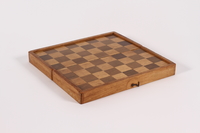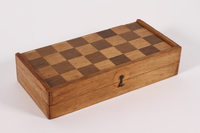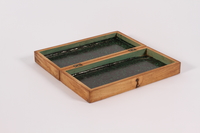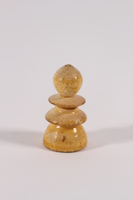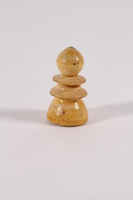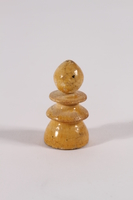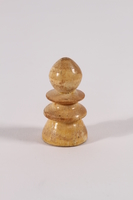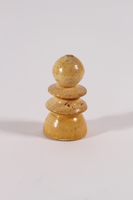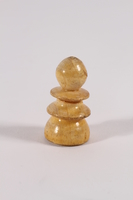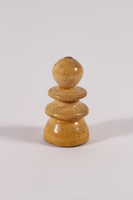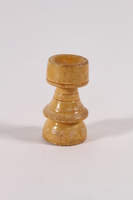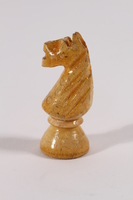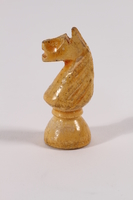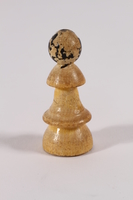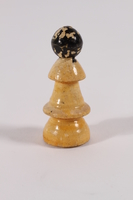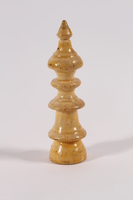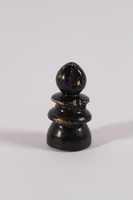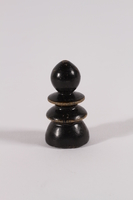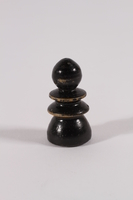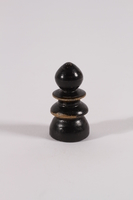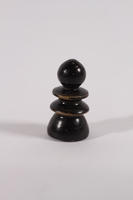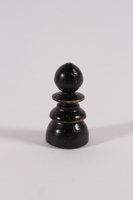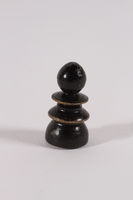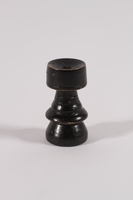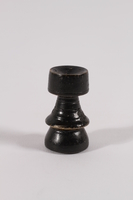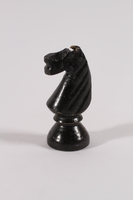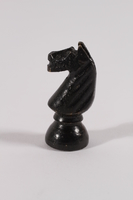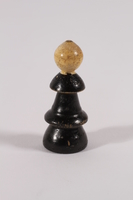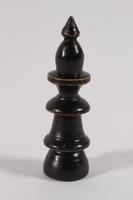Overview
- Brief Narrative
- Nekvasil portable chess set brought to the United States from Vienna by Alfred Berg, an Austrian Jewish refugee, in 1939. Nekvasil was a game and toy manufacturer in the Ottakring District of Vienna that was known primarily for making chess sets. Alfred was a teenage boy living in Vienna with his parents and younger sister Charlotte when Germany annexed Austria in the Anschluss on March 13, 1938. German authorities quickly created new legislation that restricted Jewish life. Alfred was targeted by bullies because of his Jewish heritage and on November 9-10 during the Kristallnacht pogrom, his father was arrested and later released by local police. In May 1939, Charlotte was one of fifty Jewish children from Vienna selected by Americans Gilbert and Eleanor Krauss to be rescued from the Nazis and taken to the United States. Days before the mission was to leave Vienna one of the children became ill and was unable to travel. Alfred was selected to take his place. Alfred and Charlotte arrived in New York on May 23, and later in the year their parents were able to immigrate to the United States. On June 11, 1943, Alfred was drafted. He joined the Navy Seabees (Construction Battalion) as a private and was sent to Okinawa, Japan, but arrived after the war ended. After his service ended, Albert returned to New York where he met and married Marianne Salomon, a fellow Holocaust survivor.
- Date
-
manufacture:
before 1939
- Geography
-
creation:
Vienna (Austria)
acquired: Vienna (Austria)
- Credit Line
- United States Holocaust Memorial Museum Collection, Gift of Marianne Berg
- Contributor
-
Subject:
Alfred Berg
Manufacturer: Nekvasil
- Biography
-
Alfred Berg (1924-2013) was born in Vienna, Austria, to Julius and Frieda Berg. Frieda was born in Poland, and immigrated to Vienna as a young girl with her family. Alfred’s father was born in Narajow, Germany (now Porajów, Poland) and was an orphan with no immediate family. He fought for Germany during World War I and afterward he moved to Vienna where he met his future wife. Alfred had a sister, Charlotte, who was six years younger than him. Their father worked as a tailor, Alfred and Charlotte went on picnics and swam in the Danube, the family had a nice, comfortable life.
On March 13, 1938, Austria was annexed into Germany in what became known as the Anschluss. German authorities quickly created new legislation that restricted Jewish life. Jews were arrested, required to report their assets, and segregated in public places. After the Anschluss, Alfred was attacked by other boys for being a Jew. During Kristallnacht, Alfred’s father was arrested and taken to the police precinct where his head was shaved, he was only released because he was the commanding officer’s tailor. After Kristallnacht the Bergs began looking for ways to escape Austria. In preparation for immigration to Palestine, Alfred began to learn how to farm.
In early 1939, a Jewish couple from Philadelphia, Gilbert and Eleanor Kraus, with support from the president of the Independent Order of Brith Sholom, Lewis Levine began developing a plan to rescue Jewish children inside Nazi Germany. They were able to obtain 50 U.S. visas and then travelled to Germany in April to select the children for rescue. Upon their arrival the Krauses were told by the Consular Chargé d'Affaires that there were over 200 eligible children in Vienna, and they immediately left for the Austrian capital. In May, Alfred’s sister Charlotte was selected for rescue. Just days before they were to leave Vienna, one of the children, Heinrich Steinberger became ill. Because he was too sick to travel, the Krauses chose Alfred to take his place. Charlotte and Alfred boarded a train to Berlin with the rest of the children on May 21. They arrived in Berlin later that day and were scheduled for physical examinations and final processing the following day. From Berlin they went to Hamburg, Germany, and boarded the SS President Harding and left for New York on May 23. They arrived on June 3 and were taken to the Brith Sholom retreat in Pennsylvania. While there they took courses in civics and US history, as well as English-language training.
After the retreat, Charlotte lived with distant relatives in Brooklyn, NY and Alfred stayed with a foster family in Jersey City, NJ. Charlotte was distraught; she missed her mother and was not eating. Alfred visited his younger sister every weekend until their parents emigrated in December, 1939. Reunited, the family settled in Brooklyn where Alfred’s father worked for 3G, making suits. On June 11, 1943, Alfred was drafted. He joined the Navy Seabees (Construction Battalion) as a private and was sent to Okinawa, Japan. However, before he arrived in Okinawa, the war ended. While in the navy Alfred was picked on by the other sailors because of his Jewish heritage.
After his service ended, Albert returned to New York where he met Marianne Salomon, a fellow Holocaust survivor. Marianne emigrated from Germany to Iowa with her parents in 1938. They lived in Iowa for five years and then moved to New York. In 1953 Alfred and Marianne married. Alfred became a stock broker and Marianne worked as a legal secretary. The couple had two children and three grandchildren and lived in New Jersey.
Physical Details
- Classification
-
Toys
- Category
-
Games
- Object Type
-
Chess sets (lcsh)
- Genre/Form
- Board games.
- Physical Description
- a: Portable, brown, folding chessboard comprised of two rectangular wooden boxes joined along one side with two gold colored metal hinges inset into carved recesses to enable flush closing. The boxes are constructed with splined miter joints. The top surface of the board is covered with 64 alternating dark and light brown inlaid wooden squares that form a checkered pattern. The top is framed by a thin raised lip that is nailed to the edge of the playing surface. The interior is covered with black and green marbled paper. When closed, the front end has a black metal hook and eye latch that locks the ends together. A circle is stained in the wood from the latches’ rotation. One of the dark surface squares has a loss and there are long scratches on the wood sides. When closed the height is 5.125” and the depth is 2.250”.
b: Old Vienna style, tan colored, wooden chess pawn with a rounded base and two central turned rings that taper to a spherical finial. The bottom is flat with a small centered hole. The piece is covered with inconsistently applied lacquer that is clumped in the interior and worn off around the edges and the top. There is adhesive residue on the bottom.
c: Old Vienna style, tan colored, wooden chess pawn with a rounded base and two central turned rings that taper to a spherical finial. The bottom is flat with a small centered hole. The piece is covered with inconsistently applied lacquer that is clumped in the interior and worn off around the edges and the top. There is adhesive residue on the bottom.
d: Old Vienna style, tan colored, wooden chess pawn with a rounded base and two central turned rings that taper to a spherical finial. The bottom is flat with a small centered hole. The piece is covered with inconsistently applied lacquer that is clumped in the interior and worn off around the edges and the top. There is adhesive residue on the bottom.
e: Old Vienna style, tan colored, wooden chess pawn with a rounded base and two central turned rings that taper to a spherical finial. The bottom is flat with a small centered hole. The piece is covered with inconsistently applied lacquer that is clumped in the interior and worn off around the edges and the top. There is adhesive residue on the bottom.
f: Old Vienna style, tan colored, wooden chess pawn with a rounded base and two central turned rings that taper to a spherical finial. The bottom is flat with a small centered hole. The piece is covered with inconsistently applied lacquer that is clumped in the interior and worn off around the edges and the top. There is adhesive residue on the bottom.
g: Old Vienna style, tan colored, wooden chess pawn with a rounded base and two central turned rings that taper to a spherical finial. The bottom is flat with a small centered hole. The piece is covered with inconsistently applied lacquer that is clumped in the interior and worn off around the edges and the top. There is adhesive residue on the bottom.
h: Old Vienna style, tan colored, wooden chess pawn with a rounded base and two central turned rings that taper to a spherical finial. The bottom is flat with a small centered hole. The piece is covered with inconsistently applied lacquer that is clumped in the interior and worn off around the edges and the top. There is adhesive residue and remains of green felt on the bottom.
i: Old Vienna style, tan colored, wooden chess pawn with a rounded base and two central turned rings that taper to a spherical finial. The bottom is flat with a small centered hole. The piece is covered with inconsistently applied lacquer that is clumped in the interior and worn off around the edges and the top. There is adhesive residue on the bottom.
j: Old Vienna style, wooden, tan colored, rook chess piece with a rounded base and central turned ring that tapers up into a cylindrical concave finial. Three striations circle the piece: one at the base of the finial and two on the neck above the turned ring. The bottom is flat with a small centered hole. The piece has an unevenly applied lacquer finish with several bare spots of wood at the top and several small black stains throughout. There is adhesive residue on the bottom.
k: Old Vienna style, wooden, tan colored, rook chess piece with a rounded base and central turned ring that tapers up into a cylindrical concave finial. Three striations circle the piece: one at the base of the finial and two on the neck above the turned ring. The bottom is flat with a small centered hole. The piece has an unevenly applied lacquer finish with several bare spots of wood at the top and several small black stains throughout. There is adhesive residue and felt remains on the bottom.
l: Old Vienna style, tan colored, wooden knight chess piece carved in the shape of a horse head resting on a circular pedestal base. One side has diagonal carved ridges that represent a mane. Pointed ears extend from the top of the head, and the snout protrudes out and has a carved open mouth. The bottom is flat with a small centered hole. The piece has an unevenly applied lacquer finish with several small black stains throughout. There is adhesive residue on the bottom.
m: Old Vienna style, tan colored, wooden knight chess piece carved in the shape of a horse head resting on a circular pedestal base. One side has diagonal carved ridges that represent a mane. Pointed ears extend from the top of the head, and the snout protrudes out and has a carved open mouth. The bottom is flat with a small centered hole. The piece has an unevenly applied lacquer finish with several small black stains throughout. There is adhesive residue on the bottom.
n: Old Vienna style, tan colored, wooden, bishop chess piece with a rounded base, turned ring, central tapered shaft, rounded collar and spherical finial painted black. The bottom is flat with a small centered hole. The exterior is covered with inconsistently applied varnish that is worn off around the edges and there is loss to the black paint on the finial. There is adhesive residue on the bottom.
o: Old Vienna style, tan colored, wooden, bishop chess piece with a rounded base, turned ring, central tapered shaft, rounded collar and spherical finial painted black. The bottom is flat with a small centered hole. The exterior is covered with inconsistently applied varnish that is worn off around the edges and there is loss to the black paint on the finial. There is adhesive residue on the bottom.
p: Old Vienna style, tan colored, wooden queen chess piece with a rounded base, three turned rings, and a rounded finial with a pointed spire tip.The bottom is flat with a small centered hole. The exterior is covered with inconsistently applied varnish that is worn off around the edges. There is adhesive residue on the bottom.
q: Old Vienna style, tan colored, wooden king chess piece with a rounded base, three turned rings, and a triangular finial with a pointed spire tip. The bottom is flat with a small centered hole. The exterior is covered with inconsistently applied varnish that is worn off around the edges. There is adhesive residue on the bottom.
r: Old Vienna style, black painted, wooden chess pawn with a rounded base and two central turned rings that taper to a spherical finial. The bottom is flat with a small centered hole. The finial and turned ring have an indentation on one side and the paint has worn off of the edges and the top. There is adhesive residue on the bottom.
s: Old Vienna style, black painted, wooden chess pawn with a rounded base and two central turned rings that taper to a spherical finial. The bottom is flat with a small centered hole. The paint has worn off around the edges and the top and the base have several chips and flat spots. There is adhesive residue on the bottom.
t: Old Vienna style, black painted, wooden chess pawn with a rounded base and two central turned rings that taper to a spherical finial. The bottom is flat with a small centered hole. The paint has worn off around the edges and the top. There is adhesive residue on the bottom.
u: Old Vienna style, black painted, wooden chess pawn with a rounded base and two central turned rings that taper to a spherical finial. The bottom is flat and covered with felt. The paint has worn off around the edges and the top and the base have several chips and flat spots.
v: Old Vienna style, black painted, wooden chess pawn with a rounded base and two central turned rings that taper to a spherical finial. The bottom is flat with a small centered hole. The paint has worn off around the edges and the top. There is adhesive residue and felt remains on the bottom.
w: Old Vienna style, black painted, wooden chess pawn with a rounded base and two central turned rings that taper to a spherical finial. The bottom is flat with a small centered hole. The paint has worn off around the edges and the top. There is adhesive residue and felt remains on the bottom.
x: Old Vienna style, black painted, wooden chess pawn with a rounded base and two central turned rings that taper to a spherical finial. The bottom is flat with a small centered hole. The paint has worn off around the edges and the top. There is adhesive residue and felt remains on the bottom.
y: Old Vienna style, black painted, wooden chess pawn with a rounded base and two central turned rings that taper to a spherical finial. The bottom is flat and covered with felt. The paint has worn off around the edges and the top and the base have several chips and flat spots. There is adhesive residue on the bottom.
z: Old Vienna style, black painted, wooden rook chess piece with a rounded base and central turned ring that tapers up into a cylindrical concave finial. Three striations circle the piece: one at the base of the finial and two on the neck above the turned ring. The bottom is flat with a small centered hole. There is adhesive residue on the bottom.
aa: Old Vienna style, black painted, wooden rook chess piece with a rounded base and central turned ring that tapers up into a cylindrical concave finial. Three striations circle the piece: one at the base if the finial and two on the neck above the turned ring. The bottom is flat with a small centered hole. The paint has slightly rubbed off the edges and the wood is chipped at the top. There is adhesive residue on the bottom.
ab: Old Vienna style, black painted, wooden knight chess piece carved in the shape of a horse head resting on a circular pedestal base. One side has diagonal carved ridges that represent a mane. Pointed ears extend from the top of the head, and the snout protrudes out and has a carved open mouth. The bottom is flat with a small centered hole. The paint has slightly rubbed off the edges and there are some chips at the top. There is adhesive residue and felt remains on the bottom.
ac: Old Vienna style, black painted, wooden knight chess piece carved in the shape of a horse head resting on a circular pedestal base. One side has diagonal carved ridges that represent a mane. Pointed ears extend from the top of the head, and the snout protrudes out and has a carved open mouth. The bottom is flat with a small centered hole. The paint has slightly rubbed off the edges and there are some chips at the top. There is adhesive residue and felt remains on the bottom.
ad: Old Vienna style, black painted, wooden bishop chess piece with a rounded base, turned ring, central tapered shaft, rounded collar and spherical finial. The bottom is flat with a small centered hole. The finial is unpainted, revealing the tan colored wood. There is adhesive residue and felt remains on the bottom.
ae: Old Vienna style, black painted, wooden queen chess piece with a rounded base, three turned rings, and a rounded finial with a pointed spire tip. The bottom is flat with a small centered hole. The paint is worn off around the edges and the top. There is adhesive residue and felt remains on the bottom.
af: Old Vienna style, black painted, wooden king chess piece with a rounded base, three turned rings, and a triangular finial with a pointed spire tip. The bottom is flat with a small centered hole. The paint is worn off the edges and the top. There is adhesive residue and felt remains on the bottom. - Dimensions
- a: Height: 10.125 inches (25.718 cm) | Width: 10.250 inches (26.035 cm) | Depth: 1.125 inches (2.858 cm)
b: Height: 1.375 inches (3.493 cm) | Diameter: 0.625 inches (1.588 cm)
c: Height: 1.250 inches (3.175 cm) | Diameter: 0.750 inches (1.905 cm)
d: Height: 1.250 inches (3.175 cm) | Diameter: 0.750 inches (1.905 cm)
e: Height: 1.250 inches (3.175 cm) | Diameter: 0.750 inches (1.905 cm)
f: Height: 1.250 inches (3.175 cm) | Diameter: 0.750 inches (1.905 cm)
g: Height: 1.250 inches (3.175 cm) | Diameter: 0.750 inches (1.905 cm)
h: Height: 1.250 inches (3.175 cm) | Diameter: 0.750 inches (1.905 cm)
i: Height: 1.250 inches (3.175 cm) | Diameter: 0.750 inches (1.905 cm)
j: Height: 1.250 inches (3.175 cm) | Diameter: 0.750 inches (1.905 cm)
k: Height: 1.250 inches (3.175 cm) | Diameter: 0.750 inches (1.905 cm)
l: Height: 1.625 inches (4.128 cm) | Diameter: 0.750 inches (1.905 cm)
m: Height: 1.625 inches (4.128 cm) | Diameter: 0.750 inches (1.905 cm)
n: Height: 1.625 inches (4.128 cm) | Diameter: 0.750 inches (1.905 cm)
o: Height: 1.625 inches (4.128 cm) | Diameter: 0.750 inches (1.905 cm)
p: Height: 2.250 inches (5.715 cm) | Diameter: 0.750 inches (1.905 cm)
q: Height: 2.625 inches (6.668 cm) | Diameter: 0.750 inches (1.905 cm)
r: Height: 1.250 inches (3.175 cm) | Diameter: 0.750 inches (1.905 cm)
s: Height: 1.250 inches (3.175 cm) | Diameter: 0.750 inches (1.905 cm)
t: Height: 1.250 inches (3.175 cm) | Diameter: 0.750 inches (1.905 cm)
u: Height: 1.250 inches (3.175 cm) | Diameter: 0.750 inches (1.905 cm)
v: Height: 1.250 inches (3.175 cm) | Diameter: 0.750 inches (1.905 cm)
w: Height: 1.250 inches (3.175 cm) | Diameter: 0.750 inches (1.905 cm)
x: Height: 1.250 inches (3.175 cm) | Diameter: 0.750 inches (1.905 cm)
y: Height: 1.250 inches (3.175 cm) | Diameter: 0.750 inches (1.905 cm)
z: Height: 1.250 inches (3.175 cm) | Diameter: 0.750 inches (1.905 cm)
aa: Height: 1.250 inches (3.175 cm) | Diameter: 0.750 inches (1.905 cm)
ab: Height: 1.250 inches (3.175 cm) | Diameter: 0.750 inches (1.905 cm)
ac: Height: 1.625 inches (4.128 cm) | Diameter: 0.750 inches (1.905 cm)
ad: Height: 1.625 inches (4.128 cm) | Diameter: 0.750 inches (1.905 cm)
ae: Height: 2.325 inches (5.905 cm) | Diameter: 0.750 inches (1.905 cm)
af: Height: 2.625 inches (6.668 cm) | Diameter: 0.750 inches (1.905 cm) - Materials
- a : wood, adhesive, paper, metal
b-af : wood, adhesive
b-q : lacquer
n, o, r-af : paint
h, k, v-y, ab-ae : felt
Rights & Restrictions
- Conditions on Access
- No restrictions on access
- Conditions on Use
- No restrictions on use
Keywords & Subjects
- Topical Term
- Chess sets--Austria. Jews--Austria--Vienna. Holocaust, Jewish (1939-1945)--Austria--Vienna--Personal narratives. Austria--Emigration and immigration. Jewish refugees--Pennsylvania. Jews--Persecution--Austria--Vienna--Biography. United States--Emigration and immigration--Biography.
- Geographic Name
- Austria. United States.
- Personal Name
- Kraus, Gilbert, 1897-1975. Kraus, Eleanor, 1903-1989.
Administrative Notes
- Legal Status
- Permanent Collection
- Provenance
- The Chess set was donated to the United States Holocaust Memorial Museum in 2015 by Marianne Salomon Berg, the wife of Alfred Berg.
- Record last modified:
- 2022-08-17 08:06:46
- This page:
- https://collections.ushmm.org/search/catalog/irn525821
Download & Licensing
In-Person Research
- By Appointment
- Request 21 Days in Advance of Visit
- Plan a Research Visit
- Request to See This Object
Contact Us
Also in Salomon and Berg families collection
The collection consists of a chess set, a harmonica, documents, photographs, and publications relating to the experiences of Alfred Berg in Austria and Marianne Salomon Berg in Germany before and during the Holocaust.
Date: 1930-1945
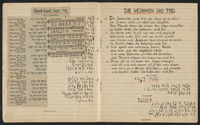
Berg family papers
Document
Consists of a handwritten songbook, report card, United States visa card, passport (Fremdenpass), a copy of a letter, magazine page, and two photographs owned by Alfred Berg, originally of Vienna, Austria. Berg's visa card and passport were obtained when he immigrated to the United States in 1939 as part of the "50 children" group facilitated by Gilbert and Eleanor Kraus. The magazine page shows photos of the children and of the Krauses and drew attention to their story. Also includes a photograph of Berg as a "Seabee" in the mid-1940s and a photograph of Elfriede Toch, circa 1944, who was one of the other "50 children."
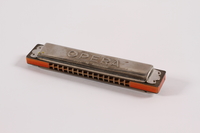
Tremolo style Opera harmonica owned by an Austrian Jewish refugee
Object
Opera brand harmonica acquired by Alfred Berg as a child in Vienna, Austria before his emigration in 1939. The harmonica was made by the Max Spranger Company based in Brunndöbra, Germany. Alfred was a teenage boy living in Vienna with his parents and younger sister Charlotte when Germany annexed Austria in the Anschluss on March 13, 1938. German authorities quickly created new legislation that restricted Jewish life. Alfred was targeted by bullies because of his Jewish heritage and on November 9-10 during the Kristallnacht pogrom, his father was arrested and later released by local police. In May 1939, Charlotte was one of fifty Jewish children from Vienna selected by Americans Gilbert and Eleanor Krauss to be rescued from the Nazis and taken to the United States. Days before the mission was to leave Vienna, one of the children became ill and was unable to travel. Alfred was selected to take his place. Alfred and Charlotte arrived in New York on May 23, and later in the year their parents were able to immigrate to the United States. On June 11, 1943, Alfred was drafted. He joined the Navy Seabees (Construction Battalion) as a private and was sent to Okinawa, Japan, but arrived after the war ended. After his service ended, Albert returned to New York where he met and married Marianne Salomon, a fellow Holocaust survivor.
Dictionary
Object
Alfred Berg was a teenage boy living in Vienna with his parents and younger sister Charlotte when Germany annexed Austria in the Anschluss on March 13, 1938. German authorities quickly created new legislation that restricted Jewish life. Alfred was targeted by bullies because of his Jewish heritage and on November 9-10 during the Kristallnacht pogrom, his father was arrested and later released by local police. In May 1939, Charlotte was one of fifty Jewish children from Vienna selected by Americans Gilbert and Eleanor Krauss to be rescued from the Nazis and taken to the United States. Days before the mission was to leave Vienna one of the children became ill and was unable to travel. Alfred was selected to take his place. Alfred and Charlotte arrived in New York on May 23 and later in the year their parents were able to immigrate to the United States. On June 11, 1943, Alfred was drafted. He joined the Navy Seabees (Construction Battalion) as a private and was sent to Okinawa, Japan, but arrived after the war ended. After his service ended, Albert returned to New York where he met and married Marianne Salomon, a fellow Holocaust survivor.
Josef and Hildegard Salomon family papers
Document
Consists of a photograph, documents, and booklets owned by Marianne Salomon, originally of Frankfurt, Germany, who immigrated with her parents to the United States in 1938, eventually settling in Iowa. Includes a pre-war photograph of Marianne; inventory and shipping correspondence related to the family's personal possessions in the late 1930s; documents related to the family's Oct. 1938 immigration to the United States on the Hamburg Amerika Line ship "New York"; Joseph and Hildegard Salomon's naturalization papers; a map of Des Moines and welcome book for Iowa; and a war bonds stamp book used by Marianne. Also includes correspondence and report cards.

